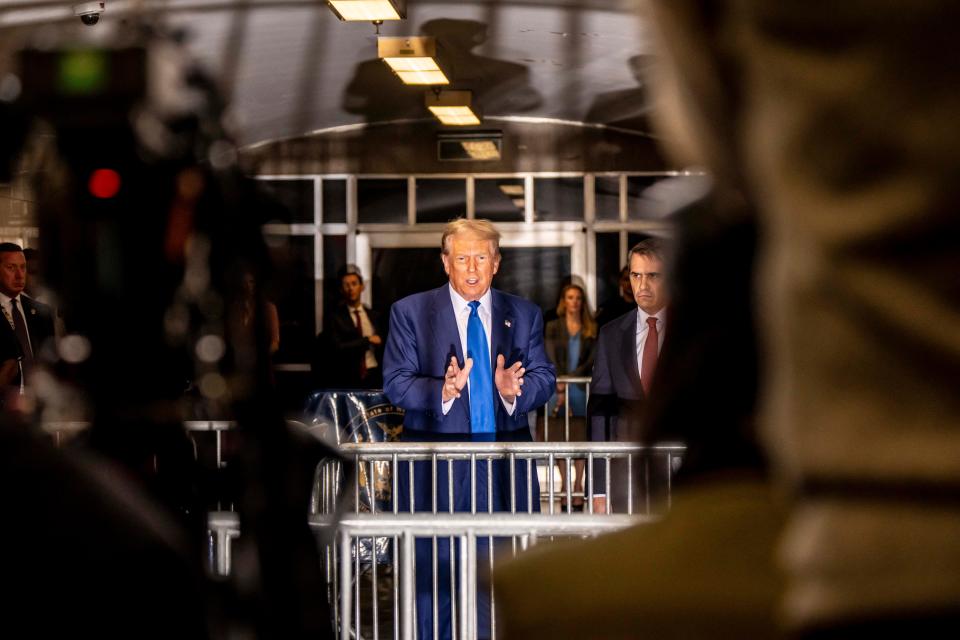-
Jurors in Trump’s hush-money trial asked the judge to re-read his ‘rain metaphor’ instructions.
-
The jury is weighing 34 counts of falsifying business records related to Stormy Daniels.
-
Jurors seem to want clarity on how to gauge Trump’s intent in the hush-money scheme.
The jury in Donald Trump’s criminal hush-money trial had a specific request before starting deliberations on Thursday — they asked to hear again what they described in a note as the judge’s “rain metaphor” instruction.
It advises a jury that they can infer that it’s raining — by seeing someone’s wet umbrella, for example — even if they don’t see the rain themselves.
The request suggests they may be weighing Trump’s intent, which can only be inferred, not proven.
The “rain metaphor,” as the jury note called it, is often used by judges in jury instructions.
It tells the jurors that they can infer certain facts from the surrounding circumstances using their common sense.
“Suppose you go to bed one night when it is not raining, and when you wake up in the morning, you look out your window,” the judge, New York Supreme Court Justice Juan Merchan, told jurors, reading from the jury instructions he gave Wednesday.
“You do not see rain, but you see that the street and sidewalk are wet and that people are wearing raincoats and carrying umbrellas,” Merchan told the jurors, who appeared to listen closely.
“Under those circumstances, it may be reasonable to infer — that is, conclude — that it rained during the night,” the judge said.
“In other words, the fact of it having rained while you were asleep is an inference that might be drawn from the proven facts of the presence of the water on the street and sidewalk, and people in raincoats and carrying umbrellas,” he concluded.
Jurors are paying close attention
Jurors were visibly engaged as they listened.
Juror 3, a young corporate lawyer, and Juror 5, a charter school teacher, each leaned forward in their seats in the front row of the jury box as Merchan read what they called “rain metaphor.”
Juror 4, a young male security engineer who sat between them, took notes.
Also taking notes was Juror 7, a middle-aged lawyer who had said during jury selection that “I’m a litigator, so I take the law seriously and I take the judge’s instructions very seriously.”
As the judge described how to infer Trump’s intent “beyond a reasonable doubt,” the engineer, lawyer and teacher scribbled hard in their white legal pads.
Meanwhile, Juror 12, a physical therapist, held her hand to her chin as if she were concentrating during the recitation of the rain metaphor.
Juror 10 began taking notes as the judge explained how Trump may have violated campaign finance laws — a possible path to finding him guilty of the business falsification charges.
Why intent matters
The jurors are considering 34 counts of whether Trump falsified business records as part of a scheme to cover up a hush-money payment to Stormy Daniels ahead of the 2016 presidential election. They deliberated for four-and-a-half hours Wednesday.
On Wednesday afternoon, they asked for the judge to read back roughly a half-hour of testimony. The requested read backs suggest they had dived deep into the details of the alleged conspiracy to influence the 2016 election by keeping Daniels quiet about an affair she says she had with Trump.
They asked for the “rain metaphor” specifically on Thursday morning.

Trump, who is 77 years old, does not use email or send text messages.
There is no evidence that he ever typed up a memo saying something like, “I’m going to falsify documentation of payments to my lawyer Michael Cohen in order to violate section 17-152 of the New York Election Law, also breaking campaign finance and tax laws along the way.”
So in order to find Trump guilty, jurors would need to infer his role in the hush-money scheme based on the testimony and documents in the case surrounding him.
Thursday morning’s jury request may show that jurors have yet to agree on whether Trump intended to conceal some other crime when he caused business records to be falsified.
After the judge completed his recitation of the jury instructions, two of the court stenographers re-read portions of the testimony. They playacted as the questioning lawyers and the witnesses who previously took the stand.
A middle-aged court stenographer with glasses sat in the witness stand seat and played the roles of ex-National Enquirer publisher David Pecker and of Michael Cohen.
The jurors had also asked if they could have a pair of headphones with a 35-millimeter jack so that they could listen to audio recordings included on the laptop of evidence they have with them in the jury deliberations room.
The judge said they could. And that he’d throw in speakers, too.
Read the original article on Business Insider
Source Agencies



